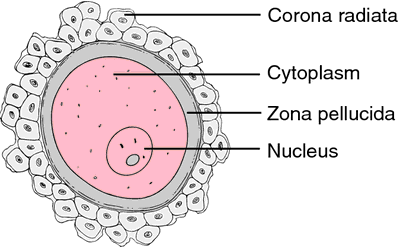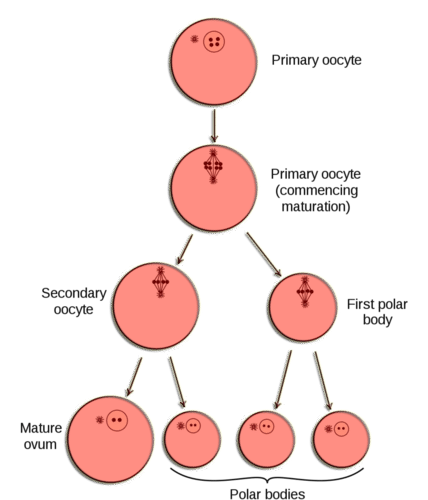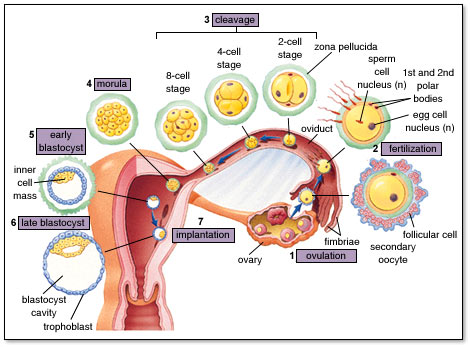Egg Cells Study Guide
Introduction
Ova is the largest human cell, with a diameter of up to 0.2 mm. They are the equivalent of a female gamete, have a spherical form and are created during embryological development in the ovaries.
Let’s dive deeper into understanding egg cells and how they develop in the human body.
Structure of an Egg Cell:
-
A vitelline membrane, zona pellucida, and corona radiata are some of the egg envelopes that enclose the structure of the egg.
-
The vitelline membrane is a thin, transparent inner membrane. The ovum itself produces it.
-
The intermediate zona pellucida, which is thin, translucent, and non-cellular. They are secreted in part by follicular cells and in part by oocytes.
Important factors about the Human Ovum and Reproduction
The merging of two different sex cells termed gametes results in sexual reproduction. Female gametes are known as eggs or ova, while male sex cells are known as spermatozoa. Fertilization and the formation of a zygote happen after both fuse together.
- The egg cell contains the nucleus, cytoplasm, zona pellucida, and corona radiata.
- The zona pellucida is a protective membrane covering the cell membrane, while the corona radiata is a protective layer of cells surrounding the zona pellucida.
- The sperm adheres to the ovum at the zona pellucida during fertilization.
- Then, the spermatozoa can penetrate the ovum and discharge their contents into the ovum.
Development of the Egg Cell:
The egg’s development begins before the female who carries it, is even born. By the time the female is born, all of the egg cells that the ovaries will release during the active reproductive years of the female have already been present in the ovaries. These cells are known as primary oocytes.
-
Each ovary contains around 200 000 primary oocytes at birth, but this amount drops to around 40 000 by puberty.
-
Ovaries and their follicles degenerate throughout time, and during a woman’s reproductive years, less than 400 mature eggs will ever be produced from the ovary at ovulation.
-
The ovum completes its initial meiotic division just before ovulation.
-
One cell, which becomes the secondary oocyte, receives half of the chromosomes but practically all cellular material (cytoplasm).
-
The remaining half chromosome is discarded away in a little bag with a trace amount of cytoplasm. This is known as the polar body.
-
The zona pellucida and the cumulus oophorus enclose the secondary oocyte and the polar body.
-
The secondary oocyte begins its second meiotic division soon after this event, but it is stopped, much like the fetus’s first meiotic division.
-
The follicle ruptures, and the secondary oocyte erupts, surrounded by cumulus cells.
-
The adjacent finger-like extensions that stretch from the open end of the Fallopian tubes take up the ovulated egg plus cumulus from the peritoneal cavity.
-
The ova then moves along the fallopian tube into the uterus. The fallopian tube is the site of the fertilization of sperm and ovum.
-
When both the sperms and the ovum simultaneously enter the fallopian tube, fertilization occurs, leading to the formation of a diploid zygote.
-
The second meiotic division of the egg cell is completed during fertilization, followed by the release of the second polar body.
-
The zygote moves along the fallopian tube and enters the uterus. The zygote then gets embedded in the uterine wall. This process is known as implantation.
-
The zygote will undergo cleavage and mitotic divisions to develop into an embryo. Further development of the zygote takes place in the uterus. After nine months, a fully grown child will be born after a gestation period.
-
If fertilization does not occur, the secondary oocyte will eventually degenerate. It is important to note that the second meiotic division will not occur if fertilization does not occur. In the absence of fertilization, the uterine endometrium will start to degenerate and shed away.
-
This degenerated tissue will be flushed out of the body with blood through the vagina. This will mark the beginning of menstrual bleeding/periods. The degenerated secondary oocyte also gets flushed out of the body and the menstrual blood.
-
A new cycle will start after the menstrual bleeding stops, leading to new secondary oocytes.
Conclusion:
- An ovum (plural ova) is a single cell produced from one of the female reproductive organs, the ovaries.
- The egg cell contains the nucleus, cytoplasm, zona pellucida, and corona radiata.
- Ova is the largest human cell, with a radius of up to 0.1 mm.
FAQs:
1. What is the name for egg cells?
Human egg cells are also called ovum (plural ova).
2. What produces an egg cell?
Female primary sex organ i.e the ovaries, produce one or two egg cells/ovum during each menstrual cycle.
3. Is a human egg a cell?
Yes, the human egg is also a type of cell known as a sex cell or female gamete.
4. Are sperms alive?
Sperms are male gamete cells produced by the testes. And like all other types of cells present in a human body, sperms are also living.
5. What is the size of a sperm cell?
Each sperm cell is about 0.002 inches or about 50 micrometers in length.
6. Can a woman be born without egg cells?
In certain genetic conditions like turner’s syndrome, a female individual is born without egg cells in the ovaries leading to permanent sterility. Certain infections during fetal development can also lead to no eggs in the ovaries.
7. What is in the sperm cells?
A sperm cell contains genetic material; the acrosome head contains enzymes that help the sperm penetrate the egg cell during fertilization, mitochondria, and a microfilament that makes up the tail.
We hope you enjoyed studying this lesson and learned something cool about Egg Cells! Join our Discord community to get any questions you may have answered and to engage with other students just like you! Don’t forget to download our App to experience our fun, VR classrooms – we promise, it makes studying much more fun! 😎
Sources:
- Egg Cells. https://flexbooks.ck12.org/cbook/ck-12-biology-flexbook-2.0/section/13.63/primary/lesson/human-egg-cells-bio/. Accessed on 30 Nov, 2021.
- 5 Female Egg Cell Facts You Should Know. https://www.naturalcycles.com/cyclematters/5-facts-about-the-female-egg-cell. Accessed on 30 Nov, 2021.
- Egg Cells. https://flexbooks.ck12.org/cbook/ck-12-middle-school-life-science-2.0/section/11.69/primary/lesson/human-egg-cells-ms-ls/. Accessed on 30 Nov, 2021.
- Female Reproductive System. https://my.clevelandclinic.org/health/articles/9118-female-reproductive-system. Accessed on 30 Nov, 2021.



